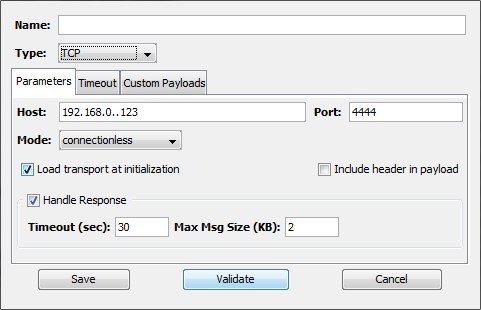The TCP transport definition panel allows you to specify the IP address or host name, and port number of the TCP server application. It also allows you to specify:
- Connection and Transaction timeouts
- The connection mode: connection_oriented or connectionless
- If the transport will receive and process response data sent from the TCP server application.
Procedure
Follow these steps:
- Using the Workbench access a node and navigate to the transport panel and select the New button to bring up a transport definition panel.
- In the Name parameter, type a
unique name for the transport.
A TCP transport name can be up to 64 characters in length and can include letters, numbers, and the underscore character. You will not be able to type invalid characters. For example, spaces are not allowed. You will not be able to insert a space in the name. - Use the Type down-arrow, and then
select TCP.
The Transport window changes to accommodate the definition of a TCP transport.
Parameters tab

| Parameter | Description |
|---|---|
| Host | The IP address or host name of the computer where you want the messages sent. This is where the TCP server application program is running. |
| Port | The port number to use to connect to the TCP server application. |
| Mode | The type of TCP connection
management The options are:
|
| Load transport at initialization | An option to have the TCP transport connect to the TCP server application when the node starts. |
| Include header in payload | The data, or payload, that is sent
by the TCP transport will begin with an
8-byte header. The first 4-bytes will
be the length of the data (not
including the 8-byte header), and the
next 4 bytes are set to zero and
reserved for future use. Sending a
header with the data makes it easier
and more efficient for the TCP server
application program to know how many
bytes to receive and process. The byte ordering of the header is big-endian. |
| Handle Response | An option to indicate that the TCP
Transport can receive response data
sent by the TCP application. This feature is only allowed when the Mode is set to connectionless and the Include header in payload checkbox is unchecked. You specify how the response data is to be processed in a Transport Map. When this option is selected, additional fields become enabled as described below. |
| Timeout (sec) | The number of seconds that the TCP
transport will wait for response data
from the TCP server application. This
value should be less than the
Execution timeout
specified on the
Timeout tab. If the
Transaction action that is being
processed has output data parameters
the TCP transport will wait until one
of the following conditions occurs:
|
| Max Msg Size(KB) | The maximum response message size in Kilo-Bytes that the TCP transport will receive in a response from the TCP server application. If there are more bytes available in the response, the transport will report this as an error. |
Timeout tab

| Parameter | Description |
|---|---|
| Connection (seconds) | The length of time the system will try to connect to a target TCP server application. For more information, see Connection timeout. |
| Execution (seconds) | How long the system should wait
(once the connection is made) for a TCP
transaction to complete. For more
information, see Execution
(sec). If you have defined the TCP transport to handled response data, make sure that this value is greater than the Timeout specified in the Handle Response section. |
Custom Payloads tab
For information on the Custom Payloads tab, see Custom Payloads tab.
Testing and saving the TCP transport
- To test the connection, select Validate. The validation consists of establishing a connecting to the TCP server application.
- If no errors are received, select Save. The transport definition is saved to the node.
The name of the new transport is added to the Transports tab and will be available for use by a transport map.
Limitation (failure to detect the connection has been reset)
This limitation applies to release 13.1 and earlier (for the Mitsubishi MESInterface IT product, version 1.12N and earlier). In release 13.2 (and version 1.14Q), the TCP transport's support of the connection_oriented mode includes improved detection of the partner TCP server application terminating the connection.
It is possible the TCP transport might not detect that
the connection has been terminated by the TCP server
application.
When this occurs, the specific behavior depends on the
operating systems involved with the node and the TCP server
application. The transactions sent through the TCP
transport after the TCP server application terminates the
connection might appear to be successful on the transport
side, but the TCP server application does not actually
receive the data.
1Possible work around
If the application logic allows it, trigger actions can
be used to control the state of the TCP connection. In the
trigger where the Transaction action is used to send data
via the TCP transport, insert the Control Transport
State (Resume Operation) and Control Transport
State (Suspend Operation) around the Transaction
action. This will cause the TCP transport to connect (on
the Resume) before the action and disconnect (on the
Suspend) after the action every time the trigger sends a
transaction.
The possibility of an old connection is greatly reduced,
since the connections are not maintained between the
sending of the data.